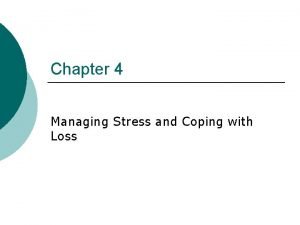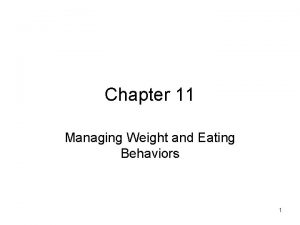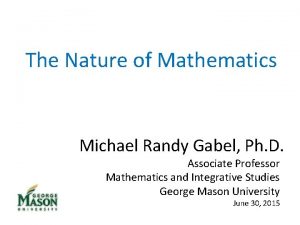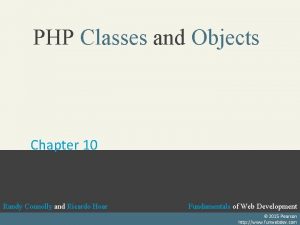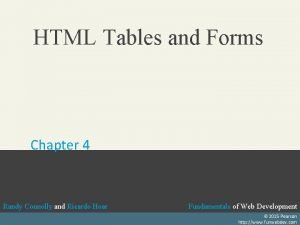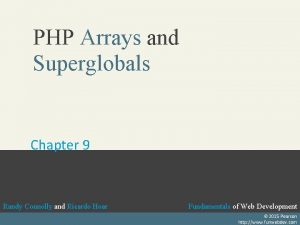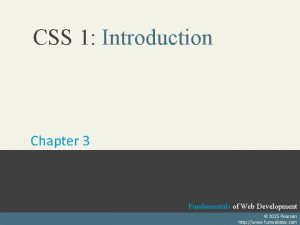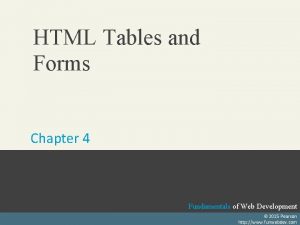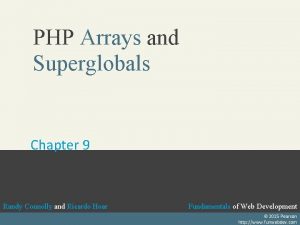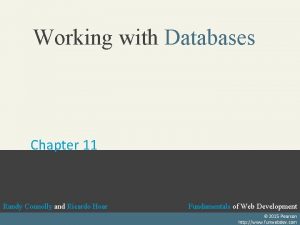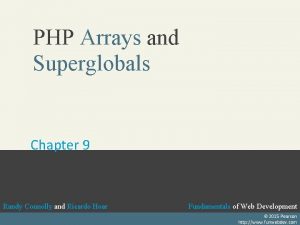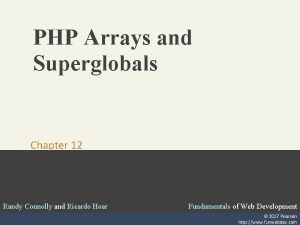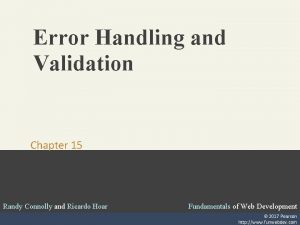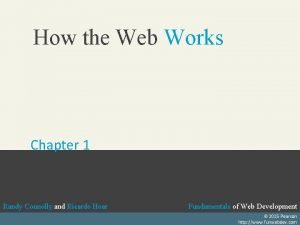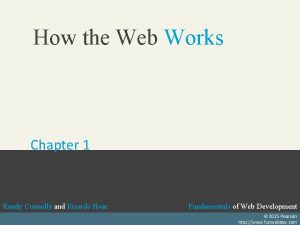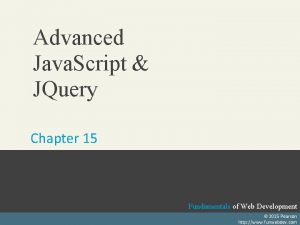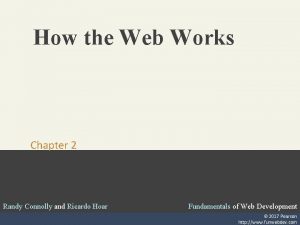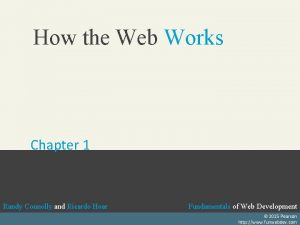Managing State Chapter 13 Randy Connolly and Ricardo














































- Slides: 46

Managing State Chapter 13 Randy Connolly and Ricardo Hoar Fundamentals of Web Development Textbook to be published by Pearson © Ed 2015 in early Pearson 2014 Fundamentals ofhttp: //www. funwebdev. com Web Development

Objectives 1 The Problem of State 2 3 Passing Information via the URL Path 4 Cookies 5 Serialization 6 Session State Passing Information via Query Strings 7 Randy Connolly and Ricardo Hoar Fundamentals of Web Development

Section 1 of 8 THE PROBLEM OF STATE IN WEB APPLICATIONS Randy Connolly and Ricardo Hoar Fundamentals of Web Development

State in Web Applications Not like a desktop application Randy Connolly and Ricardo Hoar Fundamentals of Web Development

State in Web Applications Not like a desktop application Unlike the unified single process that is the typical desktop application, a web application consists of a series of disconnected HTTP requests to a web server where each request for a server page is essentially a request to run a separate program. The HTTP protocol does not, without programming intervention, distinguish two requests by one source from two requests from two different sources Randy Connolly and Ricardo Hoar Fundamentals of Web Development

State in Web Applications What’s the issue? Randy Connolly and Ricardo Hoar Fundamentals of Web Development

State in Web Applications What’s the desired outcome Randy Connolly and Ricardo Hoar Fundamentals of Web Development

State in Web Applications How do we reach our desired outcome? What mechanisms are available within HTTP to pass information to the server in our requests? In HTTP, we can pass information using: • Query strings • Cookies Randy Connolly and Ricardo Hoar Fundamentals of Web Development

Section 2 of 8 PASSING INFORMATION VIA QUERY STRINGS Randy Connolly and Ricardo Hoar Fundamentals of Web Development

Info in Query Strings Recall GET and POST Randy Connolly and Ricardo Hoar Fundamentals of Web Development

Section 3 of 8 PASSING INFORMATION VIA THE URL PATH Randy Connolly and Ricardo Hoar Fundamentals of Web Development

Passing Info via URL Path An Idealized looking link structure Dynamic URLs (i. e. , query string parameters) are a pretty essential part of web application development. How can we do without them? The answer is to rewrite the dynamic URL into a static one (and vice versa). This process is commonly called URL rewriting. Randy Connolly and Ricardo Hoar Fundamentals of Web Development

URL rewriting Search Engine (Fine… and Human) Friendly We can try doing our own rewriting. Let us begin with the following URL with its query string information: www. somedomain. com/Display. Artist. php? artist=16 One typical alternate approach would be to rewrite the URL to: www. somedomain. com/artists/16. php Notice that the query string name and value have been turned into path names. One could improve this to make it more SEO friendly using the following: www. somedomain. com/artists/Mary-Cassatt Randy Connolly and Ricardo Hoar Fundamentals of Web Development

URL rewriting Search Engine (Fine… and Human) Friendly Randy Connolly and Ricardo Hoar Fundamentals of Web Development

URL rewriting in Apache You are not yet ready grasshoper The mod_rewrite module uses a rule-based rewriting engine that utilizes Perl compatible regular expressions to change the URLs so that the requested URL can be mapped or redirected to another URL internally. Look in Chapter 19 for details on Apache and URL rewriting. Randy Connolly and Ricardo Hoar Fundamentals of Web Development

URL rewriting in Apache You are not yet ready grasshoper The mod_rewrite module uses a rule-based rewriting engine that utilizes Perl compatible regular expressions to change the URLs so that the requested URL can be mapped or redirected to another URL internally. Look in Chapter 19 for details on Apache and URL rewriting. Randy Connolly and Ricardo Hoar Fundamentals of Web Development

Section 4 of 8 COOKIES Randy Connolly and Ricardo Hoar Fundamentals of Web Development

Cookies mmmm Cookies are a client-side approach for persisting state information. They are name=value pairs that are saved within one or more text files that are managed by the browser. Randy Connolly and Ricardo Hoar Fundamentals of Web Development

Cookies How do they Work? While cookie information is stored and retrieved by the browser, the information in a cookie travels within the HTTP header. • Sites that use cookies should not depend on their availability for critical features • The user can delete cookies or tamper with them Randy Connolly and Ricardo Hoar Fundamentals of Web Development

Cookies How do they Work? Randy Connolly and Ricardo Hoar Fundamentals of Web Development

Cookies Chocolate and peanut butter Two kinds of Cookie • A session cookie has no expiry stated and thus will be deleted at the end of the user browsing session. • Persistent cookies have an expiry date specified; Randy Connolly and Ricardo Hoar Fundamentals of Web Development

Using Cookies Writing a cookie It is important to note that cookies must be written before any other page output. Randy Connolly and Ricardo Hoar Fundamentals of Web Development

Using Cookies Reading a cookie Randy Connolly and Ricardo Hoar Fundamentals of Web Development

Using Cookies Common usages In addition to being used to track authenticated users and shopping carts, cookies can implement: • “Remember me” persistent cookie • Store user preferences • Track a user’s browsing behavior Randy Connolly and Ricardo Hoar Fundamentals of Web Development

Section 5 of 8 SERIALIZATION Randy Connolly and Ricardo Hoar Fundamentals of Web Development

Serialization Down to 0 s and 1 s Serialization is the process of taking a complicated object and reducing it down to zeros and ones for either storage or transmission. In PHP objects can easily be reduced down to a binary string using the serialize() function. The string can be reconstituted back into an object using the unserialize() method Randy Connolly and Ricardo Hoar Fundamentals of Web Development

Serialization and deserialization Randy Connolly and Ricardo Hoar Fundamentals of Web Development

Serialization Consider our Artist class Randy Connolly and Ricardo Hoar Fundamentals of Web Development

Serialization Consider our Artist class The output of calling serialize($picasso) is: C: 6: "Artist": 764: {a: 7: {s: 8: "earliest"; s: 13: "Oct 25, 1881"; s: 5: "first. Name"; s: 5: "Pablo"; s: 4: "last. Name"; s: 7: "Picasso"; s: 5: "birth. Date"; s: 13: " Oct 25, 1881"; s: 5: "death. Date"; s: 11: "Apl 8, 1973"; s: 5: "birth. City”; s: 6: "Malaga"; s: 5: "works"; a: 3: {i: 0; C: 8: "Painting": 134: {a: 2: {s: 4: "size”; a: 2: {i: 0; d: 7. 799999998; i: 1; d: 3. 5; }s: 7: "art. Data"; s: 54: "a: 2: {s: 4: "date"; s: 4: "1937"; s: 4: "name"; s: 8: "Guernica"; }}i: 1; C: 9: "Sc ulpture”: 186: {a: 2: {s: 6: "weight"; s: 8: "162 tons"; s: 13: "painting. Data"; s: 133: "a: 2: {s: 4: "size"; a: 1: {i: 0; d: 15. 119999999; }s: 7: "art. Data"; s: 53: ”a: 2: {s: 4: "da te"; s: 4: "1967"; s: 4: "name"; s: 7: "Chicago"; }"; }}i: 2; C: 5: "Movie": 175: {a: 2: {s: 5: "media"; s: 8: "file. avi"; s: 13: "painting. Data"; s: 113: "a: 2: {s: 4: "size"; a: 2: {i: 0; i: 32; i: 1; i: 48; }s: 7: "art. Da ta"; s: 50: "a: 2: {s: 4: "date"; s: 4: "1968"; s: 4: "name"; s: 4: "test"; }"; }}}}} If the data above is assigned to $data, then the following line will instantiate a new object identical to the original: $picasso. Clone = unserialize($data); Randy Connolly and Ricardo Hoar Fundamentals of Web Development

Application of Serialization Remember our state problem Since each request from the user requires objects to be reconstituted, using serialization to store and retrieve objects can be a rapid way to maintain state between requests. At the end of a request you store the state in a serialized form, and then the next request would begin by deserializing it to reestablish the previous state. Randy Connolly and Ricardo Hoar Fundamentals of Web Development

Section 6 of 8 SESSION STATE Randy Connolly and Ricardo Hoar Fundamentals of Web Development

Session State Visual Randy Connolly and Ricardo Hoar Fundamentals of Web Development

Session State All modern web development environments provide some type of session state mechanism. Session state is a server-based state mechanism that lets web applications store and retrieve objects of any type for each unique user session. Session state is ideal for storing more complex objects or data structures that are associated with a user session. • In PHP, session state is available to the via the $_SESSION variable • Must use session_start() to enable sessions. Randy Connolly and Ricardo Hoar Fundamentals of Web Development

Session State Accessing State Randy Connolly and Ricardo Hoar Fundamentals of Web Development

Session State Checking Session existance Randy Connolly and Ricardo Hoar Fundamentals of Web Development

Session State Checking Session existence Randy Connolly and Ricardo Hoar Fundamentals of Web Development

How does state session work? It’s magic right? Sessions in PHP are identified with a unique 32 byte session ID. This is transmitted back and forth between the user and the server via a session cookie Randy Connolly and Ricardo Hoar Fundamentals of Web Development

How does state session work? It’s magic right? • For a brand new session, PHP assigns an initially empty dictionary-style collection that can be used to hold any state values for this session. • When the request processing is finished, the session state is saved to some type of state storage mechanism, called a session state provider • When a new request is received for an already existing session, the session’s dictionary collection is filled with the previously saved session data from the session state provider. Randy Connolly and Ricardo Hoar Fundamentals of Web Development

Session Storage It is possible to configure many aspects of sessions including where the session files are saved. The decision to save sessions to files rather than in memory (like ASP. NET) addresses the issue of memory usage that can occur on shared hosts as well as persistence between restarts. Inexpensive web hosts may sometimes stuff hundreds or even thousands of sites on each machine. Server memory may be storing not only session information, but pages being executed, and caching information Randy Connolly and Ricardo Hoar Fundamentals of Web Development

Session Storage Applications and Server Memory Randy Connolly and Ricardo Hoar Fundamentals of Web Development

Session Storage High Volume considerations Higher-volume web applications often run in an environment in which multiple web servers (also called a web farm) are servicing requests. In such a situation the in-process session state will not work, since one server may service one request for a particular session, and then a completely different server may service the next request for that session Randy Connolly and Ricardo Hoar Fundamentals of Web Development

Session Storage Web Farm Sessions: Visualizing the problem Randy Connolly and Ricardo Hoar Fundamentals of Web Development

Session Storage Visualizing the problem There are effectively two categories of solution to this problem. 1. Configure the load balancer to be “session aware” and relate all requests using a session to the same server. 2. Use a shared location to store sessions, either in a database, memcache, or some other shared session state mechanism Randy Connolly and Ricardo Hoar Fundamentals of Web Development

Session Storage Shared location with memcache Randy Connolly and Ricardo Hoar Fundamentals of Web Development

Session Storage Shared location configuration in php. ini (on each webserver) Randy Connolly and Ricardo Hoar Fundamentals of Web Development

What You’ve Learned 1 The Problem of State 2 3 Passing Information via the URL Path 4 Cookies 5 Serialization 6 Session State Passing Information via Query Strings 7 Randy Connolly and Ricardo Hoar Fundamentals of Web Development
 Fundamentals of web development randy connolly ppt
Fundamentals of web development randy connolly ppt Southleeasd
Southleeasd Prashan patel
Prashan patel Clare partridge
Clare partridge Connolly recovery audit
Connolly recovery audit Connolly lodge buckingham street
Connolly lodge buckingham street Connolly & hickey historical architects
Connolly & hickey historical architects Ocd and school refusal
Ocd and school refusal David ricardo and thomas malthus
David ricardo and thomas malthus Chapter 8 managing stress and anxiety
Chapter 8 managing stress and anxiety Chapter 4 managing stress and coping with loss
Chapter 4 managing stress and coping with loss Chapter 6 managing weight and body composition
Chapter 6 managing weight and body composition Most fad diets do follow the mypyramid guidelines.
Most fad diets do follow the mypyramid guidelines. Managing weight and eating behaviors
Managing weight and eating behaviors Chapter 1 managers and managing
Chapter 1 managers and managing Managing weight and eating behaviors
Managing weight and eating behaviors Chapter 6 managing weight and body composition
Chapter 6 managing weight and body composition 7 types of jaycustomers
7 types of jaycustomers Chapter 11 managing weight and eating behaviors answer key
Chapter 11 managing weight and eating behaviors answer key Chapter 4 managing stress and coping with loss lesson 1
Chapter 4 managing stress and coping with loss lesson 1 Designing and managing services kotler keller ppt
Designing and managing services kotler keller ppt Chase demand strategy
Chase demand strategy Developing and managing products
Developing and managing products Chapter 4 lesson 2 managing stress answer key
Chapter 4 lesson 2 managing stress answer key Managing change and innovation
Managing change and innovation Managing weight and eating behaviors
Managing weight and eating behaviors Chapter 4 managing stress and coping with loss
Chapter 4 managing stress and coping with loss Chapter 7 managing risk vision and perception
Chapter 7 managing risk vision and perception Chapter 6 managing weight and body composition
Chapter 6 managing weight and body composition The calm waters metaphor
The calm waters metaphor Randy stamper
Randy stamper Randy pausch time management
Randy pausch time management Steve randle personality
Steve randle personality Randy pausch last lecture summary
Randy pausch last lecture summary Dr randy pausch
Dr randy pausch Randy garrison
Randy garrison Randal betz md
Randal betz md Randy robinson
Randy robinson Randy malandro
Randy malandro Randy unger
Randy unger Randy conrads
Randy conrads Thomas gordon model
Thomas gordon model Randy theorem
Randy theorem Randy lawson
Randy lawson Randy oliver oxalic acid
Randy oliver oxalic acid Mt. 13, 44
Mt. 13, 44 L randy knight
L randy knight



















